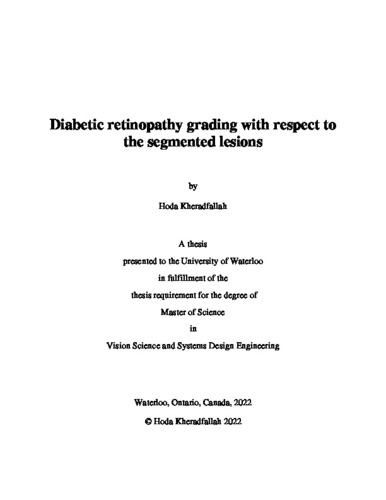| dc.contributor.author | Kheradfallah, Hoda | |
| dc.date.accessioned | 2022-05-19 15:39:39 (GMT) | |
| dc.date.available | 2022-05-19 15:39:39 (GMT) | |
| dc.date.issued | 2022-05-19 | |
| dc.date.submitted | 2022-05-14 | |
| dc.identifier.uri | http://hdl.handle.net/10012/18305 | |
| dc.description.abstract | One of the leading causes of irreversible vision loss is Diabetic Retinopathy (DR). The International Clinical Diabetic Retinopathy scale (ICDRS) provides grading criteria for DR. Deep Convolutional Neural Networks (DCNNs) have high performance in DR grading in terms of classification evaluation metrics; however, these metrics are not sufficient for evaluation. The eXplainable Artificial Intelligence (XAI) methodology provides insight into the decisions made by networks by producing sparce, generic heat maps highlighting the most critical DR features. XAI also could not satisfy clinical criteria due to the lack of explanation on the number and types of lesions. Hence, we propose a computational tool box that provides lesion-based explanation according to grading system criteria for determining severity levels. According to ICDRS, DR has 10 major lesions and 4 severity levels. Experienced clinicians annotated 143 DR fundus images and we developed a toolbox containing 9 lesion-specified segmentation networks. Networks should detect lesions with high annotation resolution and then compute DR severity grade according to ICDRS. The network that was employed in this study is the optimized version of Holistically Nested Edge Detection Network (HEDNet). Using this model, the lesions such as hard exudates (Ex), cotton wool spots (CWS), neovascularization(NV), intraretinal haemorrhages (IHE) and vitreous preretinal haemorrhages (VPHE) were properly detected but the prediction of lesions such as venous beading (VB), microaneurysms (MA), intraretinal microvascular abnormalities (IRMA) and fibrous proliferation (FP) had lower mAPs. Consequently, this will affect the value of grading which uses the segmented masks of all contributing lesions. | en |
| dc.language.iso | en | en |
| dc.publisher | University of Waterloo | en |
| dc.relation.uri | APTOS 2019 | en |
| dc.relation.uri | FGADR | en |
| dc.subject | XAI | en |
| dc.subject | explainable AI | en |
| dc.subject | deep learning | en |
| dc.subject | segmentation | en |
| dc.subject | APTOS | en |
| dc.subject | FGADR | en |
| dc.title | Diabetic retinopathy grading with respect to the segmented lesions | en |
| dc.type | Master Thesis | en |
| dc.pending | false | |
| uws-etd.degree.department | School of Optometry and Vision Science | en |
| uws-etd.degree.department | Systems Design Engineering | |
| uws-etd.degree.discipline | Vision Science | en |
| uws-etd.degree.discipline | Faculty of Engineering | |
| uws-etd.degree.grantor | University of Waterloo | en |
| uws-etd.degree | Master of Science | en |
| uws-etd.embargo.terms | 0 | en |
| uws.contributor.advisor | Lakshminarayanan, Vasudevan | |
| uws.contributor.advisor | Zelek, John | |
| uws.contributor.affiliation1 | Faculty of Science | en |
| uws.published.city | Waterloo | en |
| uws.published.country | Canada | en |
| uws.published.province | Ontario | en |
| uws.typeOfResource | Text | en |
| uws.peerReviewStatus | Unreviewed | en |
| uws.scholarLevel | Graduate | en |

